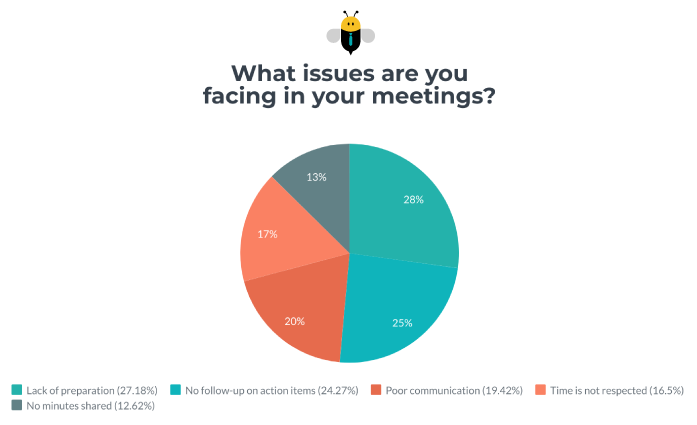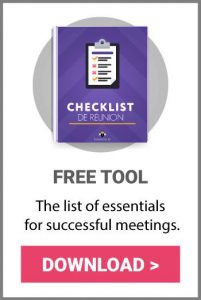We have a lot of meetings, but it’s not “glamorous” to think about improving them. There is not much openness to change; we prefer to keep the status quo. Why change? It’s the way we’ve always done it.
But you are the one who wants better meetings! Who thinks it could be better! Now is the time to take your meetings to the next level.
Meetings are important and they are here to stay because they have a real impact on the progress of projects and decision-making.
A meeting management solution is an essential tool to help you improve the entire meeting process, from planning to execution.
How to choose a meeting management solution in 8 easy steps
- Define the main issues
- Write down the short, medium, and long term objectives
- Determine the needs of your team
- Determine the features that the tool should offer
- Do a search considering these 7 benefits
- Try it out: free mode, demo, or videos
- A fair and competitive price
- Successful implementation of a new product
Step 1: Define the main issues
First, write down any problems you are facing. For example, according to an in-house survey, the top 5 problems are lack of preparation of participants, poor communication, time is not respected, no tracking of tasks, and unfortunately no minutes.

Step 2: Write down the short, medium, and long term objectives
Objectives can be focused on your team but can be as broad as managing meetings across the enterprise.
You may want better communication within the team, effective tracking of tasks and actions to follow up on meetings, a consistent, structured way of working across the entire company, etc. If you are able to quantify your objectives, it’s even better. I would like to reduce the time spent in meetings by 20% per project.
PSITT Did you know that with Beenote, customers have saved 33% in time with more productive meetings?
Step 3: Determine the needs of your team
You must identify the needs according to the participants. Who will use the tool? Will it be colleagues who love technological tools, participants with little technological knowledge, or external guests will often be part of the discussion, all of these answers perhaps?
Of course, you also need to determine what types of meetings you plan to hold, as board meetings are different from project meetings, for example.
Step 4: Determine the features that the tool should offer
Of course, there are surely some features that you want to have in your meeting management solution.
These are the essential features that will solve the problems within your team. You could make a multi-level list according to the needs of the team and teammates.
Your list could be divided into 3 selection criteria:
1. Must have
2. Should have
3. Could have
Step 5: Do a search considering these 7 benefits
Once you have a clear picture of what you’re looking to solve as a problem and what you expect to find in your future meeting tool, it’s now time to do your research. A meeting management solution should offer you all of these 7 benefits.
1- Sensitive data security
Peace of mind is the main reason to use meeting management software. The security of sensitive data is paramount. A secure solution must offer you:
- controlled access to secure confidential data
- traceability of the documents
- quick identification of the people who have had access to confidential data
- meet the criteria of the highest quality standards: ISO 27001, SOC 1 and 2
- the ability to manage multiple levels of access and roles for information access
2- Improve team and organizational collaboration
A meeting management solution allows collaborative writing of meeting documents: agenda, notes, minutes with access logging, and approval tracking.
The tool must allow for the centralization of documents, which ensures a complete cut down on email exchanges; you no longer need to notify your colleagues that your topic has been written and that it is now their turn to insert their points on the agenda. Documents are drafted jointly, with follow-up on changes to the documents made by the collaborators.
A common meeting management tool also provides a clear, uniform, and recurring presentation structure, which allows for a significant reduction in writing time and leads to greater communication during meetings.
The automation of activities such as notifications of upcoming meetings also lightens recurring administrative tasks. These automations are generated within the tool itself or integrated with your enterprise tools such as Google, Microsoft 365, or Teams.
3- Increase active participation in virtual meetings
With a corporate meeting management tool, participants have quick access to all documents. Participants can consult them, on the technology of their choice and regardless of location and time zone, before the meeting and be well prepared for the meeting. Participants will therefore feel more involved.
As mentioned in the previous point, during telework, collaborative work is more than important in virtual meetings and a good solution must facilitate work, allow several people to work together, and monitor these meetings online. As an added bonus, meetings can be recorded to keep an audio record of some of the more important and sensitive meetings.
The chosen solution should also be able to connect to a videoconferencing tool such as Beenote, which is offered as full integration to Teams.
4- Reduce meeting costs
Above all, what we are trying to reduce is the time spent on administrative procedures: printing, handling, sharing, filing, archiving, and research as well as the expenses for paper, ink, mailings, etc. A meeting management tool allows all this and more.
You reduce the costs inherent to meetings thanks to the centralized repository of electronic documents and at the same time, you save a lot of physical space in your offices due to the reduction of archived documents.
Numerous invitations are another problem in companies. It is not always necessary to invite the whole team to a meeting. Attendance management with attendance statistics can also be a major issue to reduce the costs associated with meetings. Wrong people at meetings cost you money. Do the math!
5- Facilitate sharing and search through good document management
Efficiently manage all meeting content in one place. It should be easy to search all agendas and minutes for decisions, tasks, and notes by keyword.
Good document management facilitates access to information, data sharing, and retrieval, and centralizes all documents.
Centralized documents allow you to always have the latest version available and reduce the risk of version errors.
It is also easier for the organization to have a centralized directory of all company meetings with different levels of access to keep an operational history of the company.
6- Effectively follow up on decisions and assigned tasks
Of course, a meeting management tool helps you organize your meetings; to let your team know what will be discussed (agenda) and what was actually discussed (minutes). But most importantly, your solution should help you keep track of them.
Meetings are based on a specific objective and owe their success to the achievement of that objective.
Decisions made should be recorded and kept in a register for quick access. If actions need to be taken, they should be documented and the completion of these tasks should be easily monitored by those involved.
7- Maximize investment time and minimize long-term costs with a scalable tool
The last element to consider: does the tool always seem to be evolving, improving by offering new features? Does the tool make regular updates (see versions)?
To find out, you can read blogs, and subscribe to newsletters to keep you informed of updates and new features. You can even discuss it with your account manager or talk to someone in the online support team.
Step 6: Try it out: free mode, demo, or videos
The most important thing remains to be done; test each of the solutions and evaluate them according to your needs.
Most tools offer free versions with limited features or offer access to all features for a trial period of more or less 14 days. If it is not possible for you to try them out, demos remain the alternative of choice or you may have access to videos.
For example, Beenote offers you the opportunity to try all features without limitations for a 14-day period with the ability to view online help videos for faster handling.
Step 7: A fair and competitive price
In the market of meeting solutions, most products present on their website a price based on the number of participants, specific features, team size, etc. Of course, everyone has a budget to respect, but apart from this aspect, you should rather analyze the return on investment (ROI) that this product will bring you.
Also, when you purchase the product, it is important to anticipate the implementation costs; will the support team accompany you during the implementation in your organization, and at what cost?
Is the solution available on the cloud? No. You will not need a team of experts to configure the solution.
Step 8: Successful implementation of a new product
You need to consider the 5 product adoption profiles to plan your implementation. People in your company will quickly adopt the new product if it is simple and easy to use.
When analyzing your meeting management solution, it is important to validate if you have access to webinars, demos, tutorial videos, a knowledge base, FAQs, and coaching by a qualified person. All of these elements will make it easier to implement your tool in your company at a later date and your colleagues will not be unprepared for the learning curve of this new product, which, once it is in place, will offer nothing but benefits.
In conclusion
Choosing a good meeting management solution takes time and analysis. After reading this blog, if you still have questions in the process of selecting a tool, do not hesitate to contact us, we will be pleased to guide you.
Would you prefer to try the product for yourself before asking your questions? No problem. Try Beenote Here











0 Comments